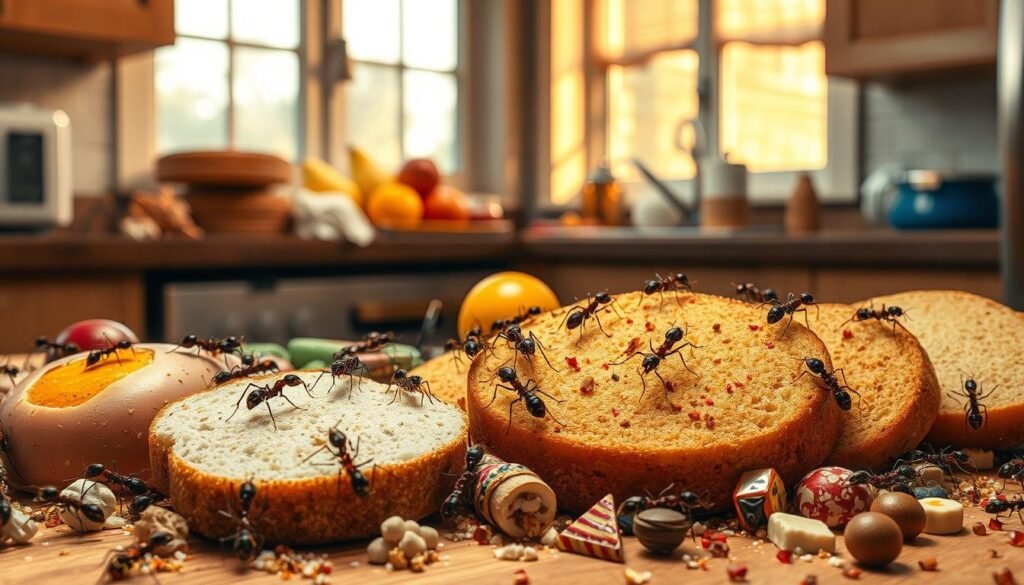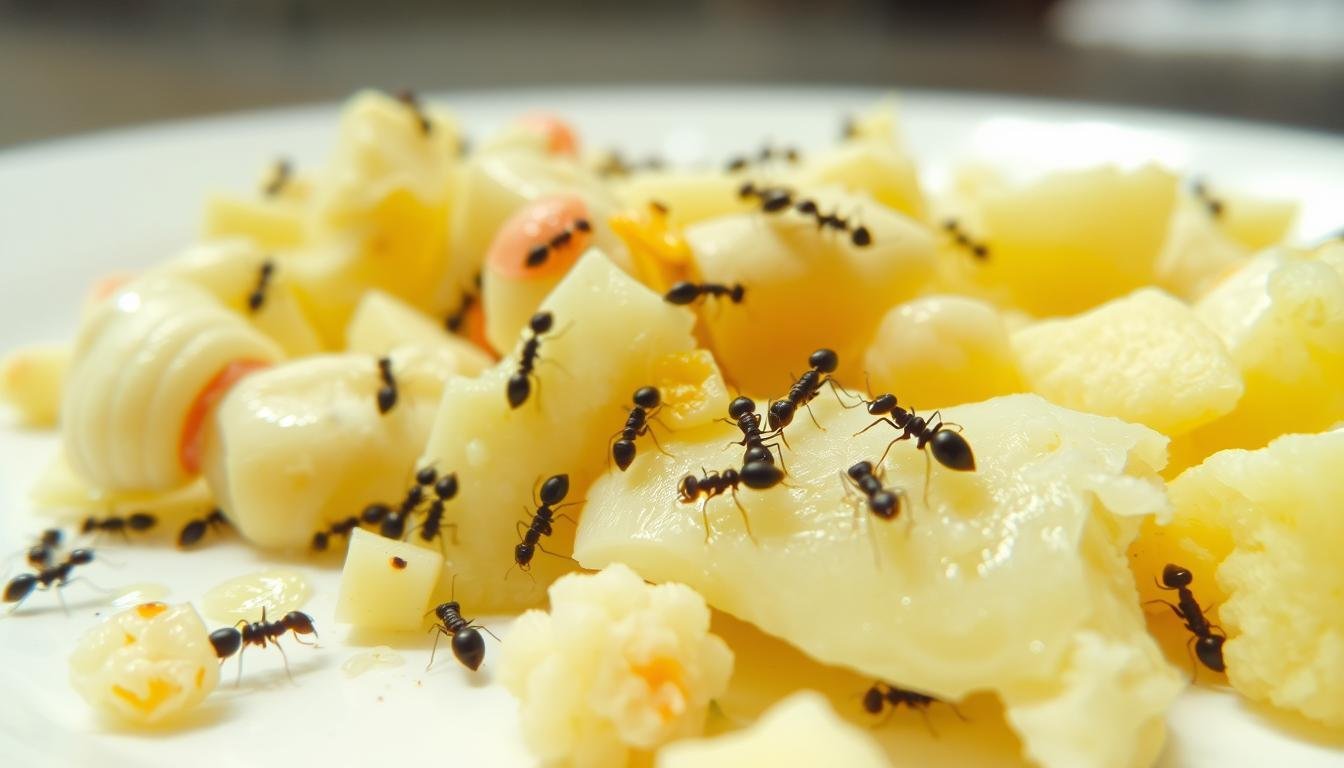Ever thought about eating food with ants on it? Ants on your food can happen a lot, especially in summer. But is it okay to eat it?
Knowing the risks to food safety is key. We’ll look into the dangers of eating food ants have touched. We’ll also give tips on what to do if this happens.
Contents
- 1 Understanding the Ant Contamination Problem
- 2 Can You Eat Food If Ants Have Been on It?
- 3 Potential Health Risks of Consuming Ant-Contaminated Food
- 4 Different Types of Ants and Their Impact on Food Safety
- 5 How to Properly Clean and Salvage Ant-Contaminated Food
- 6 Conclusion on Ant-Contaminated Food and Food Safety
- 7 FAQ
- 7.1 Can ants contaminate food with diseases?
- 7.2 Are all types of ants equally likely to contaminate food?
- 7.3 How can I tell if ants have contaminated my food?
- 7.4 Can washing food remove ant contamination?
- 7.5 What should I do if I find ants in my pantry?
- 7.6 Can ants transfer bacteria to food through their saliva or feces?
- 7.7 Are there any health risks associated with consuming food contaminated by carpenter ants?
- 7.8 How can I prevent ants from contaminating my food in the future?
Understanding the Ant Contamination Problem
Ants are drawn to many foods, causing contamination and health risks. They love sweet or sticky foods but can also spoil other types.
The foods most often contaminated by ants include:
- Sugary foods like honey and syrup
- Fruits and vegetables, especially overripe or damaged ones
- Protein-rich foods like meat and pet food
| Food Type | Attractiveness to Ants | Contamination Risk |
|---|---|---|
| Sugary Foods | High | High |
| Fruits and Vegetables | Moderate | Moderate |
| Protein-rich Foods | Low to Moderate | Moderate |
Ant contamination is more than just a nuisance. It’s a serious food safety issue. Ants can spread bacteria and pathogens to food, leading to illness.
It’s important to understand the risks of ant contamination for food safety at home. Knowing which foods ants like and how to prevent contamination can help keep you safe from sick food.
Can You Eat Food If Ants Have Been on It?
When you see ants on your food, you might wonder if it’s still okay to eat. The answer depends on a few things. These include how long the ants were on the food, what kind of food it is, and how many ants there were.
Duration of Exposure
How long ants were on your food matters a lot. If they were there for just a little while, the risk might be lower. But, ants can carry bacteria and other pathogens on their bodies. They can transfer these to the food.
Being exposed for a longer time raises the risk of contamination. For example, if ants have been eating on the food or if it’s been out for a long time, it’s more likely to be contaminated.
Type of Food Affected
The kind of food ants were on is also important. Foods that are high in sugar or protein attract ants more. For instance, sweet liquids or meats can draw ants and become breeding grounds for bacteria.
- Sweet or sticky foods like honey or syrup
- Protein-rich foods such as meat or eggs
- Damp or moist foods that can spoil easily
Number of Ants Involved
The number of ants on your food also matters. A single ant might not be a big deal, but many ants can be risky. Ants can contaminate food with their saliva, feces, or body parts, making it potentially hazardous to eat.
In conclusion, whether you can eat food with ants on it depends on several factors. By looking at how long the ants were there, what kind of food it is, and how many ants there were, you can decide if it’s safe to eat.
Potential Health Risks of Consuming Ant-Contaminated Food
Ants can carry harmful bacteria and pathogens. They can make your food unsafe. This can lead to serious health issues.
When ants get into your food, they bring risks. They can spread bacteria and other harmful substances. This can cause a range of health problems.
Some of the health risks include:
- Food poisoning from bacteria like Salmonella and E. coli
- Gastrointestinal issues such as diarrhea and vomiting
- Allergic reactions to ant proteins or other contaminants
These risks are serious, especially for certain groups. The elderly, young children, and those with weak immune systems are at higher risk. It’s important to keep your food safe from ants.
To avoid these risks, handle your food safely. Store it correctly. Also, keep your kitchen and pantry clean and check for ants regularly.
Knowing the risks helps you protect yourself and your family. By being aware and taking steps to prevent ants, you can lower the chance of getting sick from contaminated food.
Different Types of Ants and Their Impact on Food Safety
Did you know different ants can harm your food’s safety? Each ant species contaminates food in its own way. This makes some ants more dangerous than others.
Common ants near food include odorous house ants, pavement ants, and carpenter ants.Odorous house antslove sweet or sticky foods. They can spread bacteria and other harmful germs to your food. Pavement ants prefer moist foods.
| Ant Species | Attracted to | Contamination Risk |
|---|---|---|
| Odorous House Ants | Sweet or sticky substances | High |
| Pavement Ants | Moisture-rich foods | Moderate |
| Carpenter Ants | Protein-rich foods | Low to Moderate |

It’s important to know how ants can risk your food’s safety. By understanding which ant you have, you can tell if your food is safe to eat.
How to Properly Clean and Salvage Ant-Contaminated Food
Knowing how to clean food with ants is key for safety. Ants can make food unsafe to eat. But, not all food needs to be thrown away. It depends on the food type and how much ants have contaminated it.
Fruits with Intact Peels
Fruits with peels can often be saved by washing them well. For example, apples and bananas are safe after washing off ants.
Packaged Foods with Minimal Exposure
For foods in packages with little ant contact, check the packaging. If it’s not damaged, the food is probably safe.
Be careful with prepared and cooked foods touched by ants. If they’ve been out too long, it’s safer to throw them away to avoid getting sick.
Sugary and Sticky Foods
Ants like sugary foods like honey and syrup. Check these foods for ants. If ants have been there, it’s best to throw them away to stay safe.
Washing Techniques for Produce
Washing fruits and veggies is important to remove ants and other dirt. Use water and vinegar or a produce wash to make sure they’re clean and safe.
| Food Type | Cleaning Method | Safety Precaution |
|---|---|---|
| Fruits with Peels | Wash under running water | Remove visible ants |
| Packaged Foods | Inspect packaging | Check for damage or contamination |
| Cooked Foods | Reheat to 165°F | Discard if left out too long |
Inspecting Packaged Foods
It’s important to check packaged foods for ants. Look for holes or ants inside. If you see any, throw the food away to stay safe.
By following these steps, you can clean and save food touched by ants. This keeps you safe and reduces waste.
Conclusion on Ant-Contaminated Food and Food Safety
You now know the dangers of eating food ants have touched. Ants can make food unsafe, leading to health problems. Different ants can cause different risks, and cleaning food well is important.
To keep food safe, be careful and take steps to prevent ants. Check your food often, store it right, and clean surfaces well. This way, you can stay healthy and enjoy safe meals.
Understanding the risks of ant-contaminated food is crucial. It shows the importance of careful food handling and preparation. Being aware and practicing safety can help avoid health dangers.
FAQ
Can ants contaminate food with diseases?
Yes, ants can carry bacteria, viruses, and other pathogens. This can lead to foodborne illnesses.
Are all types of ants equally likely to contaminate food?
No, not all ants are the same. Some, like odorous house ants, are more likely to be near food.
How can I tell if ants have contaminated my food?
Look for ants, ant trails, or discarded wings on your food. Also, check for unusual smells or tastes.
Can washing food remove ant contamination?
Washing can remove some contaminants. But, it might not get rid of all risks. For some foods, like fruits, washing is enough. But, for others, like prepared meals, it’s harder to avoid contamination.
What should I do if I find ants in my pantry?
If you see ants in your pantry, check all food for contamination. Throw away any bad food. Then, clean the pantry well to get rid of ants and trails.
Can ants transfer bacteria to food through their saliva or feces?
Yes, ants can transfer bacteria to food. This can lead to contamination and increase the risk of foodborne illnesses.
Are there any health risks associated with consuming food contaminated by carpenter ants?
Carpenter ants might not contaminate food as much as others. But, they can still transfer bacteria or pathogens. This poses health risks.
How can I prevent ants from contaminating my food in the future?
To keep ants away from your food, store it in sealed containers. Keep your kitchen and pantry clean. Also, eliminate standing water and moisture that ants might find attractive.

Hello, I am Bellamy George, a certified nutritionist and food safety specialist from Springfield, IL. With a degree in Food Science, I share research-backed insights on edible foods, seeds, and seafood for safe, informed eating.

